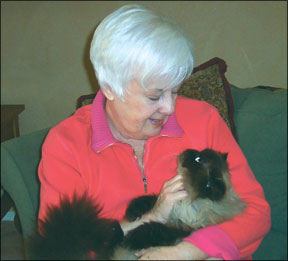Nutraceuticals in Weight-Loss Diets
With 28.7 percent of all adult American cats classified as “overweight” and 6.4 percent as clinically obese, things only get worse with age. Among cats between five and 11 years of age, fully 44 percent are either overweight or obese.
Just in time (we were about to have Frannie, the ShortTakes office kitty, fitted for running shoes) comes this report in the Journal of

288
the American Veterinary Medical Association (Vol. 232, No. 11): “Nutraceuticals and dietary supplementation for the management of obese and overweight pets.”
The study looked at everything from omega-3 fatty acid supplementation, amylase inhibitors and DHEA (dehydroepiandrosterone) to L-carnitine, CLA (conjugated linoleic acid) and dietary phytoestrogens. Some, such as diacylglycerol, make a computers spell-checker burp. And not all, including the last one, have been tested on cats.
Here are three that do seem to help overweight cats: L-carnitine (added to a low-fat diet, it made weight loss significantly easier compared to low-fat food without the supplement); CLA (supplementation “helps repartition fat” to lean tissue) and phytoestrogens (“could help prevent obesity after gonadectomy”).
Tests for Antifungal Drugs
Years ago, when a Cornell veterinarian invented a gizmo to raise fleas for science, it was dubbed the “Artificial Dog.” The device allowed fleas to bite through artificial skin to reach body-temperature cow blood inside. The name implies the device spared real dogs the agony of raising fleas for science. In fact, cats were customarily employed to raise fleas.
Now, the journal Veterinary Dermatology (Vol. 19, Issue 3) reports that simulated cat skin may be a suitable model for the screening of antifungal drugs against the dermatophyte usually blamed for ringworm in both cats and dogs.
While the Artificial Dog was larger than some real ones, biomedical engineers today are building “animals” the size of computer chips – with cell-cultured organs (including skin), tiny pumps and micro-plumbing to circulate blood and other fluids the organs need to stay alive.
The cat skin device studied by Belgian scientists uses fetal tissue (with permission of owners of the pregnant cats) together with micro-plumbing that circulates blood and the systemic drugs to be tested for efficacy against skin conditions such as ringworm.
Their conclusion: “RFE (reconstructed feline epidermis) could become a reference model for routine screening of systemic drugs against dermatophytes.”
Nine Lives, Shared with Humans
A University of Minnesota study, reported in the trade journal Veterinary Economics (Vol. 49, Issue 4), explains how cats repay the cost of keeping them.
Analyzing data on 4,435 adults, neurology professor Adnan Qureshi and his Stroke Research Center colleagues found the relative risk for heart attack was 40 percent higher among people who had never owned a cat. Put another way, 5.8 percent of non-cat owners die of heart attacks and only 3.4 percent of current or previous cat owners succumb.
Said Qureshi: “Cat ownership may relieve stress and anxiety and subsequently reduce the risk of cardiovascular diseases. If this relationship is real, then – unlike other preventive measures such as angioplasty or medications – this (cat ownership) seems to be very low risk and may not need to be evaluated like other medical interventions.”



